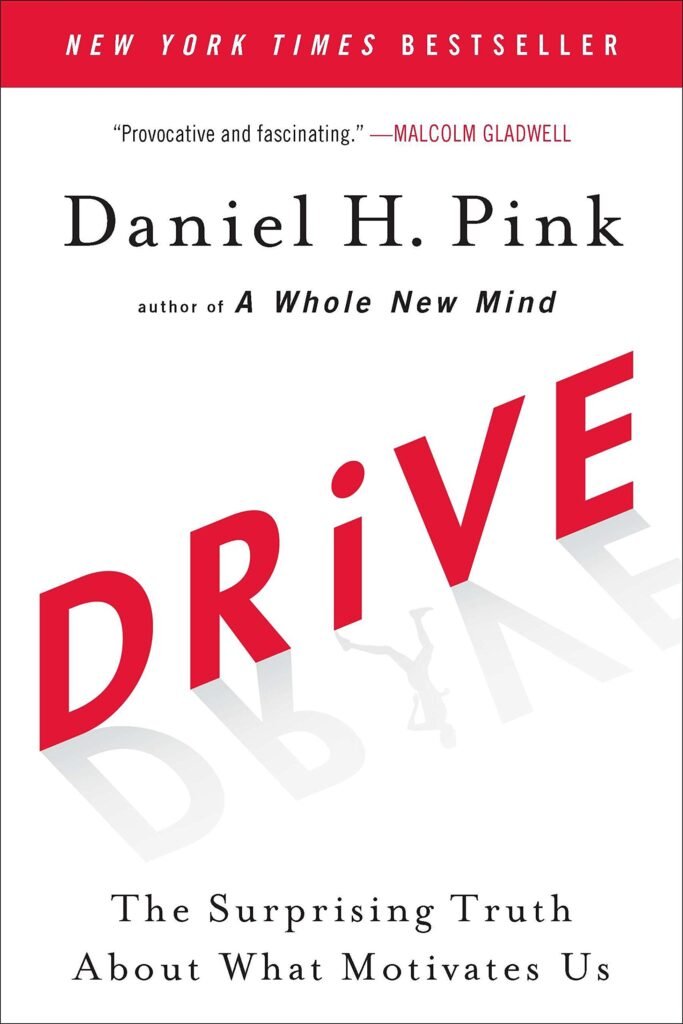“The freedom to try out new concepts is the greatest form of freedom for innovative groups.”
Drive
What Drive people to act the way they do? There are numerous reasons, but intrinsic motivation is the most powerful. Individuals, businesses, governments, schools, and even parents should strive to cultivate and encourage intrinsic motivation. An amazing book on why and how businesses should be designed for the twenty-first century.
Here, outlines three factors that create true motivation in Behavioral Motivation:
Autonomy is defined as the desire to have control over one’s own life.
Mastery is defined as the desire to constantly improve and expand one’s knowledge on any subject.
Ideal – the desire to contribute to others in addition to oneself.
Momentum levels 1.0 and 2.0
From approximately 50,000 years ago to the last few centuries, humans were only concerned with survival – they were motivated by motivation 1.0 – basic needs such as finding food and drink, earning a safe place to sleep, and the desire to copulate in order to reproduce and perpetuate the species.
However, as the age of industrialization progressed, this began to change. The production cycle is becoming more complex, and people are motivated to work in new ways: Exogenous Motivation 2.0 entails third-party rewards or punishments, also known as “Sticks and carrots.” Its strategy is to use rewards to encourage desirable behaviour while punishing undesirable behaviour.
In Drive Motivation 2.0 has taken over the workplace. Most business owners believe that rewards and punishments are two of the most important factors in motivating employees to work.

Intrinsic Motivation 3.0
Play a mechanical puzzle with 8 monkeys. They have no 1.0 or 2.0 motivation to drive and solve the puzzle if they are not given food or praise. However, the monkeys tried again and, after grasping the operation, solved happily without any outside assistance. Humans are as well.
Have you ever wondered how the massive encyclopaedia Wikipedia came to be? Thousands of people have volunteered to write and edit Wikipedia articles simply because they are interested. They invest their valuable time and effort without receiving any monetary compensation.
Despite the fact that Wikipedia is mostly composed of amateur writers, it has grown and achieved great success. In comparison, Wikipedia’s rival product, Microsoft’s Encarta dictionary, paid a lot of professional authors and editors but still failed and had to be shut down a few years ago.
What motivates human and animal behaviour in the two examples above? That’s version 3.0 of intrinsic motivation. When a person finds work he enjoys, it doesn’t take many incentives to keep him working.
Intrinsically motivated people prefer to make their own decisions and accept responsibility for their actions. They don’t require direction or rewards because they enjoy and are willing to do things without expecting anything in return.
When the “stick and carrot” strategy failed
Motivation 2.0 is effective for repetitive tasks such as grocery shopping because it increases employee productivity, but it is ineffective for difficult or creative tasks. Then this method is ripe for fraud or underperformance.
In most garages, for example, if a mechanic completes a certain amount of repair work in a certain amount of time, they will be rewarded. Employers anticipate that extrinsic incentives will motivate employees, resulting in satisfied customers.
However, the strategy has disastrous consequences: workers are only concerned with achieving results in order to receive rewards; they even fix unnecessary parts that make customers uncomfortable and give them a negative impression of the company.
The carrot promise frequently yields the same mixed results. In India, an agility test is being held. Participants are paid if the ball hits the target, and, surprisingly, those who are promised the most money perform the worst. Financial incentives make them feel more pressured, which not only hinders their performance but also their psychology.
The most dangerous situation occurs when the “carrot and stick” method, combined with basic needs – motivation 2.0 and 1.0 – causes people to lose sight of motivation. 3.0: Extrinsic motivation suffocates intrinsic motivation. We are highly motivated from within as children: we are not afraid to learn and observe everything around us. However, as we grow older, our desire for new experiences and challenges diminishes. We gradually stop honing our skills. When people are forced to live in a world where everything is dependent on extrinsic motivation, intrinsic motivation gradually fades away.
Intrinsic motivation for excellence
Successful people in their respective fields all share one key component of Motivation 3.0: an inner drive to perfection. It assists them in bettering themselves and maintaining their passion and determination in pursuit of their goals.
Creative people who strive for perfection frequently work in a “climax,” when they are completely immersed in the task and lose sight of the outside world. This state does not last long, but it is associated with perfectionism, continuous development, and leads to a new “climax.” People strive for success and believe in continuous improvement.
People who are difficult to motivate are those who believe that their skills have not improved significantly since the beginning, no matter how much practise they have received. Those who believe they can grow will work hard to improve themselves. While perfection is something we will never achieve, it is still a goal we should strive for: we must be ambitious enough to do our best.
What is the book drive about?
Understanding human psychology and the dynamics that drive motivation in the 21st-century economy is the focus of the movie Drive. According to Daniel Pink, the majority of businesses have not improved their outdated “carrot-and-stick” incentives.
What motivates us really?
We all have a secret emotion that drives us to act in certain ways. Drive is comparable to motivation, but motivation results from drive.
What happens at the end of the novel Drive?
Driver cruises into the sunset battered but most likely alive while Bernie chases him, killing Shannon in the process and coming dangerously close to killing Driver.
Investigate the meaning of life.
A survey of University of Rochester students was conducted, and the question of life purpose was asked. There are people who want to make money and be famous, and there are people who want to grow personally and help others by working for international relief organisations.
The researchers returned a few years later to interview the same students to see how far they had progressed. Those who want to make money are dissatisfied, even if they have been promoted to senior management positions in large corporations. They are frequently concerned and in crisis. In contrast, the latter group claimed to live happier lives with few psychological issues.
A big goal is also more inspiring and motivating than simply wanting to do something. Instead of seeking the greatest profit, those seeking the meaning of life seek to do something that benefits society while also strengthening themselves.
Intrinsic motivation is increased by self-determination.
Some businesses have adopted a management approach that is entirely based on employee autonomy; instead of clamping down and monitoring, leaders let go of control or let employees do things on their own. Google is the most common example, as it allows its employees to set their own work schedules and devote 20% of their time to developing creative projects. This motivational strategy worked: at the time, Googlers created successful products such as Google News and Gmail.
Your teammates’ motivation is also important. Employees and managers at Whole Foods choose new employees together. Anyone who wants to be a team leader at WL Gore & Partner must find people willing to work under them. We’re all more committed to our jobs when we have agency, whether we’re scientists, cashiers, or mechanics. Some people want more control over their schedules, while others want to choose who they work with. They will develop better, be more satisfied at work, and be less prone to burnout if they are given this freedom. To summarise, self-determination has a positive effect on motivation.

Upgrade to 3.0 for increased corporate efficiency.
Although intrinsic motivation is no longer a secret, many businesses are still unsure how to capitalise on it. Employee motivation remains foreign “carrots and sticks,” and this conservative management mantra only creates passivity and inertia.
When the most creative employees are motivated from within, their productivity benefits the entire organisation. Simple measures such as surprise attention can result in significant changes. Above all, constructive criticism will help employees focus on the joy of their work, and their intrinsic motivation will naturally increase.
Those who have a say in how the company makes decisions have higher intrinsic motivation. When leaders clearly emphasise an individual’s contribution to the overall success of the company, each individual feels that their actions have meaning and becomes more committed. The perfectionist drive is also achieved through a balanced work allocation: each employee should be assigned a task of sufficient complexity to challenge their abilities, but not so difficult as to discourage them.
It is best to connect employees’ work with charities or social organisations to make them feel like they are doing good for the community. As a result, they will go to work with the satisfied knowledge that they are making a positive contribution and fighting for a greater cause. An administrator who upgrades his “operating system” to Motivational 3.0 modifies his rewards accordingly, promoting self-determination, perfectionism, and meaningful goals. As a result, employees will demonstrate a more dedicated, long-term commitment, rather than simply going to work to fulfil obligations with little ambition.
“The future belongs to a different type of person with a different type of mind.”
Drive

Thank you for your sharing. I am worried that I lack creative ideas. It is your article that makes me full of hope. Thank you. But, I have a question, can you help me?
Yes, sure i will help….
What’s your questions?